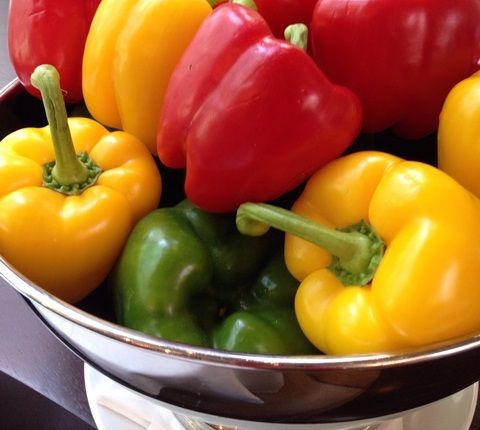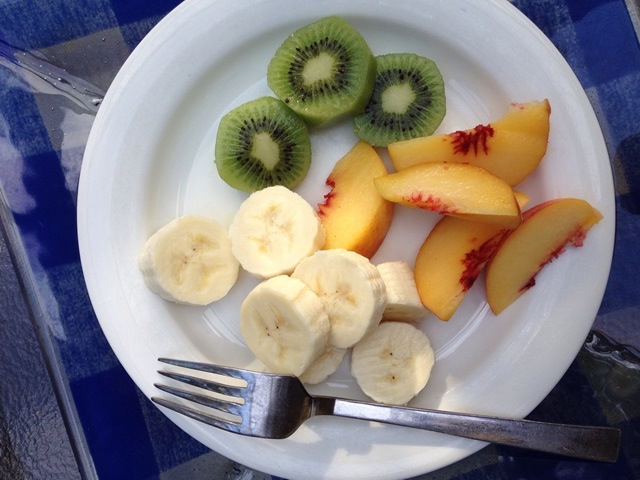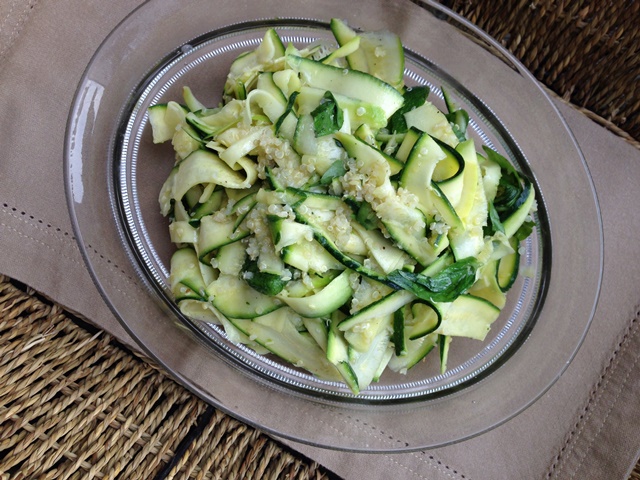- Home
- Blog
- Healthy Weight Loss
- My Raw Food Diet Roadtest
My Raw Food Diet Roadtest
Written by Catherine Saxelby on Wednesday, 30 April 2014.

As part of his series on weird and wonderful diets, James Valentine has asked me to roadtest some of them and then present my experiences and my nutritional verdict for his listeners on the Afternoon show with James Valentine on ABC radio. This month, I followed a Raw Food Diet for one week. Keep reading to see how I went.
What I ate for a week
Breakfast
Large plate of fresh, diced, fruit including a banana
Or
Blender smoothie with kale, coconut, banana and fruit e.g. sliced peach, blueberries, kiwifruit
Lunch
Large vegetarian salad (whatever vegetables I had in the fridge)
Dinner
Sashimi from the local Japanese take-away or Gazpacho (a raw vegetable soup)
Zucchini spaghetti /noodles
Grated carrot salad
More salad!
Avocado chocolate banana “mousse” or sliced fresh fruit
Snacks
Half an avocado
Banana
Any fresh fruit
Fruit salad
Handful of mixed raw nuts
Raw cacao ball from café (but sadly no coffee)
Can I eat out on a Raw Diet?

How did I cope for a week?
It’s pretty boring if you just eat the basics! However, I’ve discovered lots of interesting raw recipes for things such as:
- Zucchini ribbons or spaghetti or noodles- see picture below
- Cashew cheese aka vegetarian cream cheese or mayo (recipe below)
- Raw cacao balls (Bliss bombs)
- Chocolate avocado banana mousse (recipe below)
I started 'cooking' up dishes like cashew cheese, the yummy zucchini ribbon salad above with lemon zest, lemon rind, extra-virgin olive oil and a scattering of beige quinoa and avo banana choc mousse which surprised me with their delicious flavours and varied uses. For instance, I spread the cashew cheese on flat bread, used it as a dip with raw carrots and celery, and added it as a stuffing to mushroom caps and baby capsicums.
The verdict
Like most fad diets, it’s all right for a day or two and then it just becomes too hard to sustain, especially if you have to eat out for a working lunch or attend a dinner function. This diet requires commitment, time and planning. You can’t just grab something from the fridge or cupboard as you rush out to work. You need to plan your shop and what meals you’re going to prepare in advance. I’m not saying it can’t be done but I am saying it requires some motivation and an appropriate amount of time. I’ve said this with other fads and it applies here too.
If you want to do it then try the 80:20 rule (80% raw: 20% cooked) and you’ll find it easier. Even 50 per cent raw is a good compromise and more balanced. I found my own regular diet is around 40 per cent raw in any case due to the fruit, veges, salads, nuts and seeds I usually eat. One thing’s for sure, a Raw Diet certainly boosts your fibre, vitamins, minerals and there’s NO processed foods at all!
Two raw recipes I discovered and really liked:
Cashew cheese (vegetarian cheese)
This ‘cheese’ or ‘cream’ is a very handy and versatile raw ingredient. I used it as a spread on toast and as a dip with raw vegies. It also doubles as a stuffing for vegetable tacos or can be thinned down with water or oil to make a dressing or pasta sauce.
Prep time: 10 mins
Cooking time: nil
2 cups raw cashews, 250 g
2 cups water or to cover
Juice of one lemon (¼ cup)
½ teaspoon table salt
1 tablespoon extra-virgin olive oil
2-3 tablespoons water to mix
Place the cashews in a deep bowl and cover with the water for at least two hours. You can cover and leave overnight but make sure they are left in the fridge or else they’ll start to ferment. Rinse and drain the cashews in a colander.
Add the cashews and lemon juice, salt and oil into a food processor and process for 3-4 minutes or until completely smooth. Scrape the sides down with a spatula and blend again until all ingredients are nicely mixed. Add in extra water if needed to create a smooth consistency. Store in an airtight container in the fridge for up to a week.
Makes 2 cups (550 g)
Variation: A lot of similar recipes add 1 tablespoon nutritional yeast which adds a lovely savoury quality (think umami).
Chocolate Avocado Banana Pudding
This really amazed me when I first made it. It tastes like a soft choc mousse but with a faint banana overtone that gradually wanes over time. Your avocados need to be slightly soft to touch but not mushy or overripe when cut. Similarly your bananas should be sweet and soft but not too ripe or squishy.

Prep time: 10 mins
Cooking time: nil
2 ripe avocados
2 medium ripe bananas
5 tablespoons unsweetened raw cocoa powder
2 tablespoons agave nectar
1 teaspoon cinnamon
- Peel and slice the avocados and bananas into the bowl of a food processor. Process for 1-2 minutes or until smooth. Stop and scrape down the sides of the bowl once or twice.
- Add the cocoa powder and cinnamon. Process again and, with the processer running, drizzle in the agave to mix well. Refrigerate until ready to serve.
- To serve, place a couple of dollops of the mousse in a bowl and top with fresh raspberries or sliced strawberries.
Makes around 2 cups. Serves 4-6
Note: Store in the fridge in a sealed container and eat within 3 days.
Variation: Add honey or maple syrup instead of the agave.
You may also be interested in...
About the Author
Catherine Saxelby has the answers! She is an accredited nutritionist, blogger and award-winning author. Her award-winning book My Nutritionary will help you cut through the jargon. Do you know your MCTs from your LCTs? How about sterols from stanols? What’s the difference between glucose and dextrose? Or probiotics and prebiotics? What additive is number 330? How safe is acesulfame K? If you find yourself confused by food labels, grab your copy of Catherine Saxelby’s comprehensive guide My Nutritionary NOW!
References / External articles
The Good Stuff
The Boring Stuff
© 2023 Foodwatch Australia. All rights reserved
Author photo by Kate Williams
Website by Joomstore eCommerce












